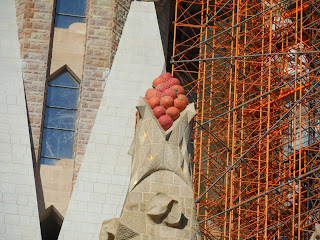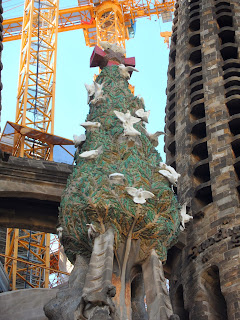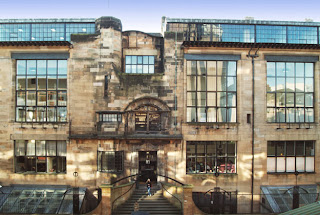Gustave Eiffel, Eifel Tower, 1889
This was actually meant to be demolished after the 'Gran exhibition' of 1889. Not typically 'art nouveau' but symbolic of the period as it was first major construction out of industrial materials that wasn't built for practical purposes - just to admire.
Victor Horta, Stairwell of the Tassel House, 1892-93
When someone says 'art nouveau' I imagine this is the type of imagery that pops up in your head. It's an all encompassing style whereby all aspects of design are considered - the wallpaper echoes the references to plants and flowers in the bannister of the stairwell. Even the shape of the stairwell winds up like curved lines.
Hector Guimard, Metrostations, Paris, 1900
The lamps look like stems with little bizarre fruit flowering at the end . References to vegetables and other 'natural' things were popping up in the most contradictory places - such as a metrostation - anything but natural. There is also slight gothic influence which isn't surprising as neo-gothicism had appeared earlier on midway through the 19th century. Also, the slight gothic tendency could be because of the fact that the gothic is often seen as something quite natural anyway. For example, think of a gothic castle. What is your first thought? I can make a guess at that it was an old derelict building with vines running up and down the walls. People often associate gothicism as architecture and art that has literally risen out of the ground in a very romantic way....Friedrich's Abbey in the Eichwald for example (pictured at the bottom).
Anton Gaudi, Casa Batllo, 1904-6
Gaudi is most famous for building what looks like melting buildings. He uses neither traditional 'post and lintel' method of building neither does he use arches. First instance since Gothic architecture whereby a new method was used.
Sagrada Familia, 1882 - forever
This is actually STILL being built. Maybe architects today can't fully get their head around Gaudi's new method, and maybe Gaudi couldn't either. Either way, it's a impressive bit of architecture until you see the gleaming white recent additions in stone.
I really hope they have a method in aging the stone or atleast put similar stone over the firebricks because this is hideous!!! But notice the references to fruits randomly coming out from the pinnacles.
The melting effect.
A christmas tree?
Rene Lalique, Jewellery
Art nouveau affected all kinds of arts and crafts. These are so pretty and have an exotic quality to them. If you've ever wondered who made exotic flowers and big curvy wurvy shapes on jewellery fashionable then this is her.
A necklace currently in Topshop:
Charles Rennie Mackintosh, Glasgow School of Art, 1897-1909
The idea of imitating nature in architecture is particularly visible here. Mackintosh has made the building look as if it's succumbed to the elements.
The artists and designers of this period had a thing with chairs. While some are of questionable taste I think Mackintosh's stuff is still quite nice. Although, I am biased because my boyfriend's mum has lots of Mackintosh stuff and I've been exposed to it all for 2 and a half years!
The language of art nouveau even reached graphic design.
Audrey Beardsley, Illustrations for Oscar Wilde's Salome, 1893.

























No comments:
Post a Comment